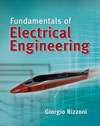
AC Power |  |
Learning Objectives1. Understand the meaning of instantaneous and average power, master AC power
notation, and compute average power for AC circuits. Compute the power factor of
a complex load. Section 7.1.
2. Learn complex power notation; compute apparent, real, and reactive power for complex
loads. Draw the power triangle, and compute the capacitor size required to
perform power factor correction on a load. Section 7.2.
3. Analyze the ideal transformer; compute primary and secondary currents and voltages
and turns ratios. Calculate reflected sources and impedances across ideal transformers.
Understand maximum power transfer. Section 7.3.
4. Learn three-phase AC power notation; compute load currents and voltages for balanced
wye and delta loads. Section 7.4.
5. Understand the basic principles of residential electrical wiring and of electrical safety.
Sections 7.5, 7.6.
|
|
|